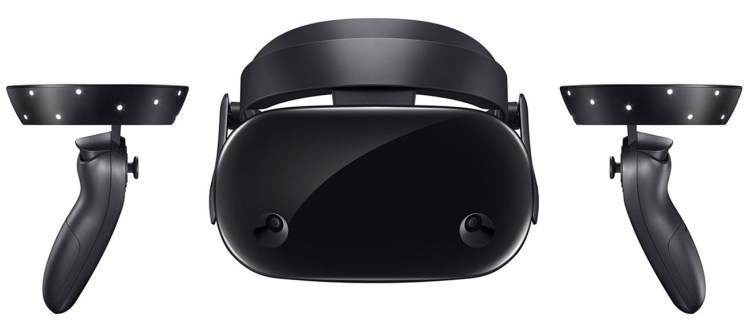Investors have moved on from virtual reality to other cool categories like crypto and blockchain and esports. But some of the established companies still see long-term potential in the VR market, particularly as it merges with the emerging markets of augmented reality and mixed reality.
Skydance Interactive and Samsung are among the companies that are believers. There isn’t much of a consumer market now, but they’re encouraged at the growth of enterprise applications and they look forward to new versions of VR hardware coming in the near future.
At the recent Greenlight Insights Virtual Reality Strategies conference in San Francisco, I talked with Amy Allison, head of community at Skydance Interactive, maker of the Archangel virtual reality mech game, and Farshid “Farsh” Fallah, director of developer relations for XR and Gaming at Samsung Electronics America.
We took a deep dive into strategies for monetization and survival in a market where the growth isn’t quite where everyone wants it to be. It was interesting to see the views of monetization from a developer and a platform owner at the same time.
Here’s an edited transcript of our session.
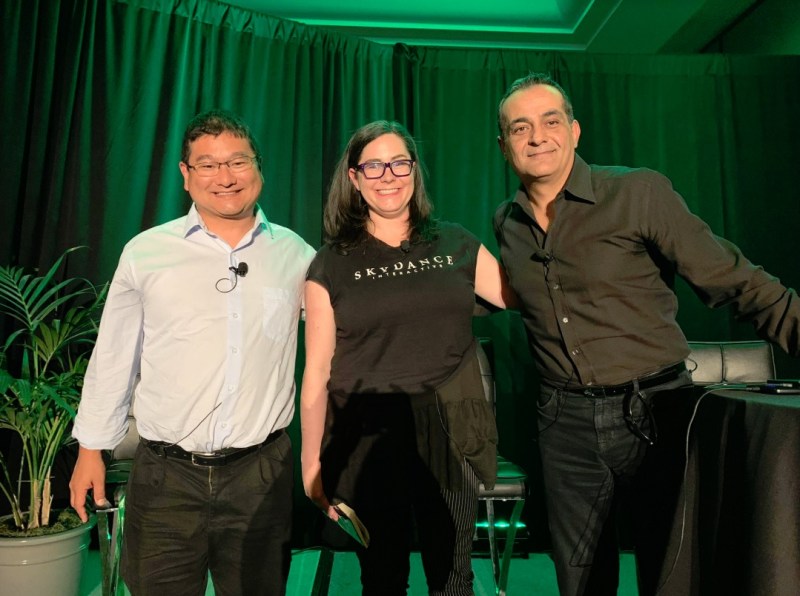
Above: Left to right: Dean Takahashi of GamesBeat, Amy Allison of Skydance, and Farsh Fallah of Samsung.
Farsh Fallah: If you look at games, you need to get a certain amount of products out to have that critical mass where the platform is viable. That hasn’t happened in VR yet. It’s going to happen. The technology is too promising. Companies like ourselves have been losing money for years on it. We’ll continue to lose money, and we don’t mind. We’ll keep investing. We know that five years from now, the phone won’t be the same thing that’s in your pocket right now. If we want to stay at number one for consumers, we’re going to have to evolve.
The technology we have right now for VR and AR is way too promising to let go. Soon VR and AR will merge together, too, which will make it even better. At some point they got separated because of hardware realities. Those hardware realities are going away.
GamesBeat: This will happen years from now, though, right?
Fallah: We don’t think it’s that many years away. To be honest, my personal feeling, probably the second half of 2020 you’ll see the critical mass, where the number cross the point to make things viable. You have the diversity and the number of people you need to make the content business work properly. Right now VR is demographically very limited. It’s very white, very male, 25-49, very coastal. That affects the content that comes out and the business models you can use.
Once we get more diversity, more of the countries in the world involved – India, China, South America other places – we’ll see a different business model and different content. More mature content, more widespread.
Amy Allison: From the developer side, the content side, we have to look at our business models, too, about really extending the marketing tails for our titles. You have a new wave of VR users almost every day. It’s not just people who are used to having new games come out because they’ve had a console for three years. Everyone’s a new consumer as soon as they buy the headset. We’re having to look at our marketing tails, keep them longer, incorporate things like tournaments and other competitions.
We tried something a little different. Our original game, Archangel, was a single-player, on-rails experience. A year later we released a multiplayer aspect to it, two on two. It was a $20 price point at first, and eventually we got to a point where we were proud of the game, we knew it was strong, but we just didn’t have enough players, so we opened it up to be a free-to-play game. We’re looking to see how those learnings will pan out. It’s working a bit, but with our games it’s hard to tell. It’s a steep learning curve. It’s a very intense game, aimed at that 18-24 male shoot-em-up kind of audience.
We’re setting out examples of scenarios to test, but we haven’t seen the data come back yet to be able to say that this was the right move, or this is the way we should have gone. We know that it’s a loss leader situation right now. We want to establish ourselves as leaders in the space. We want to provide people with entertainment that they can’t get somewhere else. Five years from now, we hope to still be a part of the game. We limit our development cycles to one year, one and a half years, because beyond that point there’s no way to ever recoup, or even keep the costs manageable.
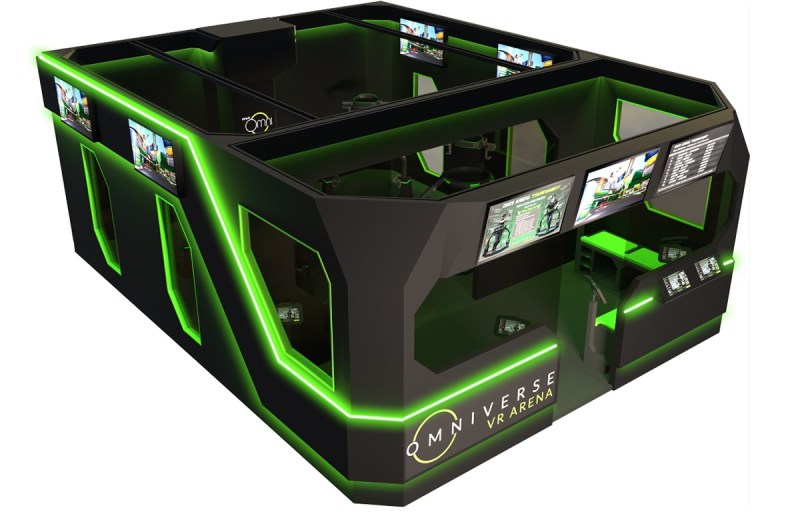
Above: Virtuix and Funovation are targeting VR arcades. It’s an example of a VR pivot.
GamesBeat: Switching business models like that seems to have been very common in the fledgling VR industry.
Fallah: It’s so new that nobody really knows what works well. Because our demographic is limited, what works for this demographic may not work once we expand outward. So yes, we see a lot of switching going on. On the platform side we try to make available any business model, most of the business models that people are thinking about. We like to see new business models and make our platforms available for that type of thing.
One thing we’ve seen coming up lately, and we’re bettering it as we speak right now – we’ll probably launch it by the end of this year – is trying to get advertisers to pay for VR games. The idea is to have some type of playable ad where, if the consumer agrees to watch it – they’re not forced to – then you get a certain amount of money for each ad to put toward the purchase of the game, and that goes to the devs. We were hoping the market would do this already, but it hasn’t happened yet. I think Samsung got tired of waiting. We’ve started coding it ourselves and we’ll probably just put it out there.
Another thing we’re hoping to see soon is the platform sides working together. I’ve proposed this to our competitors, to open our servers up and connect all the players together. It didn’t go over too well. I’m hoping in a few years we can talk again. Cross play is the way of the future. You have to allow people to play with each other. We’re still friendly enough where we can talk about it, so hopefully soon.
GamesBeat: It seems like the earliest business model for everyone was to go to the platform companies that wanted good content and ask them to fund it. This has lasted quite a long time. If you look at Facebook, they talked about putting $250 million into content, and then $250 million more promised. From a developer point of view, that’s interesting, but I guess you can’t count on it forever.
Fallah: We don’t operate our own store, so we count on our partners to put up content funding. We fund the hardware. But we’re hoping that will come to an end soon. We want devs to be able to have their own ecosystem, make their own money, and have projects without any kind of ceiling. It’s taking longer than anyone wanted, but this is the same way gaming got started when I was a kid. When Nintendo came out, at first they developed most of the games for their own console. So did most of the big consoles. Even phone developers – at Apple we used to do that any time we had new products coming out. You have to jumpstart things.
Eventually you want the platform guys to pull back and let the devs take over. We’re waiting for that critical mass to happen.
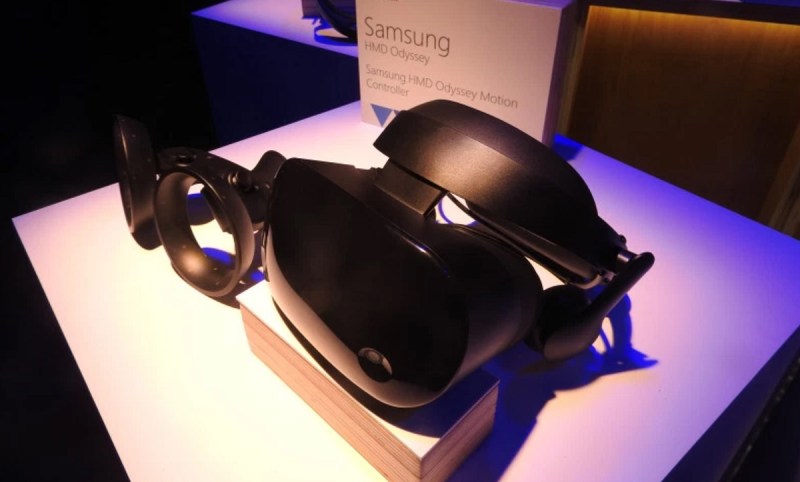
Above: Samsung HMD Odyssey VR headset
GamesBeat: Looking at it from the developer point of view, there are some interesting choices out there. Oculus has been aggressive with its money. Samsung hasn’t. Vive has an accelerator program. What kind of options for platform money does that present?
Allison: It’s not necessarily just development money. It’s the support you get after that. Oculus is really trying to work with you if you’re going to go and do demos, because that’s a partnership position, really going around and figuring out how to do our best. They’ll work with you to make sure you have the hardware on hand. It goes beyond just development dollars. We don’t get that kind of support from other partners as much. It really does make you start establishing priorities as far as who you focus on, because they’re so kind with their marketing support as well as their development dollars. The store pages, whether it’s Steam or Oculus or Viveport, those are also really a factor in how much money you can bring back for your title — whether they’re helping you bundle stuff or not, and so on.
GamesBeat: If you’re setting up an ecosystem and you want developers to come into it, what do you have to entice them?
Fallah: We have a couple of things going for us. One of them is access. We’re the number one phone manufacturer in the world. Many people don’t know, but we’re also the largest chipmaker in the world, the largest TV maker in the world, the largest chipset manufacturer in the world. I once went to a map and tried to find places where we don’t have an office. I could only pick out two countries: North Korea and Syria. The Syria office got bombed. We’re still paying all the staff while we wait to open up again. North Korea, well, if there’s peace, maybe one day?
We have people on the ground and we can give global access. That’s part of what we offer. Second to that is ad support. Also, I have many engineers on my team. We fly them all over the place. Whatever engine you’re working on, whether it’s Unity or Unreal or something bespoke, these guys to the code level in people’s games and optimize them, make them work better, make them bug-free. We help deliver better graphics and optimization.
I’m sure you’ve seen our high-end Odyssey headset. We’re partnering with Microsoft on the MR store for that. Our mobile solutions are working with Oculus. We’re hoping that can cover the gaps we have on the content side.
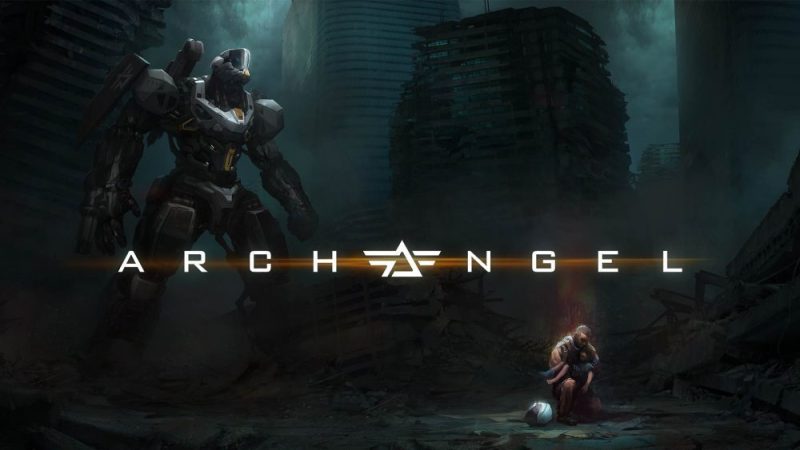
Above: Archangel is Skydance Interactive’s debut VR game.
GamesBeat: If you had the choice of Magic Leap, with $2,295 glasses that the developer can buy in order to develop their games or application, or you have money being given to you by Oculus–it’s an interesting set of choices.
Allison: It depends on the content you want to do. Is it built for city planning? Then it’s probably better to work with an AR application. But for gaming, I don’t see a lot of AR excitement there right now. Especially if you’re not going to have support from the hardware providers to give you that oomph to go and do it. For me, it just depends on what type of product or experience you want to create. But if Oculus is going to give me a headset and send me to boot camp, that seems obvious, what an indie dev would choose.
GamesBeat: This week, Sixense was in the news. As far back as 2013 they were doing 6DOF controls for VR. They raised $600,000 on Kickstarter and started working, but never shipped it. But they did go to work with Penumbra, a health care company, to develop tech for that market. Now they’ve sold a $20 million stake in that joint venture and they’re taking that money to pay back their Kickstarter backers. So they started out with this fantasy of the consumer market, but they ended up with enterprise as the model that gets them money for development to reach their next product. It’s an interesting story of how the market has driven people to pivot.
Fallah: We were involved in that a bit as well. Right now, the one area of VR that’s doing very well monetization-wise is enterprise VR solutions. We have massive contracts with large companies that are using it, including the military in the U.S. and Europe. That’s why we know this isn’t going away. They’re spending so much money investing in it.
Part of that was us. When I was at Unity, I used to argue with Palmer Luckey and the guys at Oculus all the time, that their EULA was too restrictive. We felt there was one line in the EULA that killed any money that devs could make, which was the one that said it has to be for entertainment only. It limited devs to making entertainment, and it kept them from doing work on the side that they might actually get paid for.
We still have limitations. I have enterprise solutions that come along all the time that I can’t put on the Oculus store. You have to find a way to download it and use it. We tend to do custom solutions for these customers on the side through our VR browser, which is very popular. It’s not really the optimal way of doing it. We hope more platforms will open it up, not limiting themselves to one type of app or another. Let the devs go out there and get some business going. Enterprise is paying very well right now.

Above: Archangel: Hellfire.
GamesBeat: Skydance is all about entertainment, right?
Allison: They are, but I also have my personal feelings. I have a very special place in my heart for what we call serious games, using the technology in fields like the military or health care. It’s not the first time that games have been used for military purposes, and then those military purposes turn back into games. For example, the Viewmaster, the little plastic thing, used to be a tool to teach fighter pilots how close they had to be to a target in order to keep from wasting their ammunition. It ended up being a very popular commercial toy after that.
That exchange doesn’t surprise me. A lot of the time you get some very good funding out of it, like you said, and it’s beneficial for everyone. I’m a big fan of that model. It’s great if companies can be agile enough to do that kind of thing. I’m glad Sixense was able to finally refund their backers.
GamesBeat: It seems like Microsoft, with HoloLens, is really targeting enterprise. If this thing is going to cost $3,000 it’s not for consumers. There was an interesting hospital application, a VR app created for a children’s hospital in Los Angeles. They were teaching medical students how to react to angry parents. That kind of training for the hospital, they said, was saving $450,000 a year. So they’re willing to pay for this kind of development.
Fallah: A lot of companies are that way. Airline companies that used to be flying their staff to hubs for training are using our headsets now. The cost-cutting is in the millions of dollars. The military are creating a lot of training applications as well. Our internal numbers, having done quite a lot of research–we’re actually doing biometric research in VR, with more than 10,000 people in one study. Our numbers tell us that the retention of information when you’re in VR is 2.4 times what it is when you’re not in VR. That’s a very high number for the people who’ve been in this game a long time, who’ve studied advertising retention and that sort of thing.
It’s great for training, but it’s also great for developers. There are all kinds of models that haven’t been explored yet. Product placement has great potential inside of gaming and other things. A lot of areas are going to open up.
Allison: A couple of my friends have jobs specifically about going out to find independent devs who are working on their fun projects, and then they augment them with these other projects that may need to be incredibly complicated, but they can do that work to support their staff and learn new things. I feel like it’s important for the ecosystem as a whole to have those partnerships.
GamesBeat: Closer to the entertainment space, Alexis mentioned VR arcades and location-based entertainment. That seems to be a bit more realistic as a place to pivot for game companies. Is that attractive to you?
Allison: It is. Right now the return is around six to twelve cents a minute, depending on the type of experience, that comes back to developers. A lot of the other costs they go to are just renting the building, that kind of thing. What arcades are charging is still varying a good deal, though. It’s come down a lot, because they’ve realized that people aren’t willing to pay as much. Or there are sliding scales where it’s cheaper on the weekdays versus the weekend.
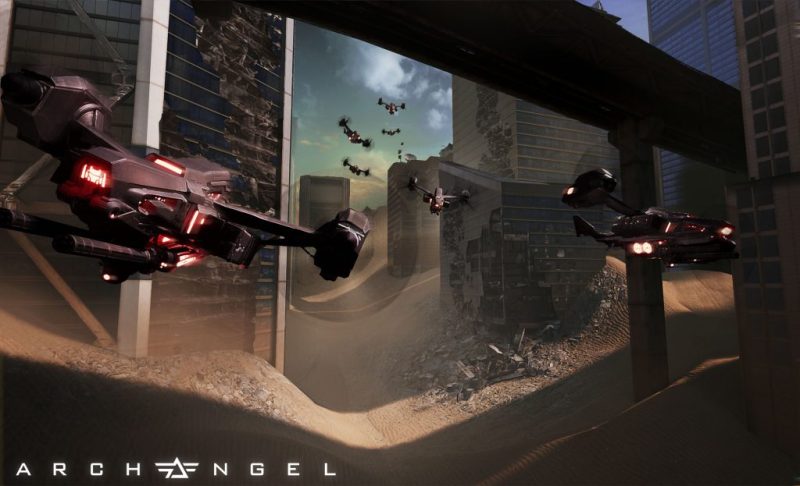
Above: Archangel lets you play in a giant mech in VR.
GamesBeat: Can that add up to enough real dollars, that it’s something you’re excited about?
Allison: It’s money coming in the door. [laughs] It’s a $200 check here, $100 check there. It’s not a whole bunch, but at least it’s a little something. You know it will end up growing. And now we’re thinking about how we can do more to support LBEs. Perhaps we can do some point of purchase stuff that brings people into the arcade. Some arcades aren’t as attractive as the Two-Bit Circus, which is incredibly elaborate. There could be more there.
I do feel like LBEs will eventually go the way of the internet cafe, along a 10-15 year timeline. But we’re finding those optimal moments to pounce on opportunities and make sure that when people do go into the LBEs, your game is the one that they select and play. Or you can do what’s really tricky like us and make a multiplayer game, so four booths are all playing your game at once. [laughs]
Fallah: Just to add to that, gaming started this way to begin with. When I was a kid you couldn’t afford, unless you were a rich kid, your own game machine at your house. You took a quarter and you went to the arcade and put it in and played your game. Until I was a teenager, in the late ‘80s–I actually worked in a Haagen-Dazs shop for six months to save enough money to buy my Nintendo. [laughs]
This is the same thing that’s happened before, over and over again in tech. When new technology comes out it’s too expensive for the mortal man. It’s a coastal thing. A bunch of rich middle-aged guys play it until it becomes cheaper and moves on down. If, 10 years ago, I told any of you that you wouldn’t be able to get away from your phone for 10 minutes now, you would have looked at me like I was crazy. But here we are. In 10 years we’ll have those kinds of conversations about VR and AR. It’ll be a natural part of life. Every one of us will have it.
Allison: A big part of that will be the ability to socialize with it, when there’s more people there. When you can do things together in VR, unlike now–today you only have one headset per house, things like that.
Fallah: A big part of why we haven’t gotten to that critical mass is the total cost of the system. Everyone worries about how much the HMD costs, or Gear versus Oculus. That’s not the total price to us at Samsung. The total price is everything you have to have to play, everything down to your internet connection and the cost of your content. That’s not there yet. A $500 headset isn’t so bad until you add a $3,000 computer to it.
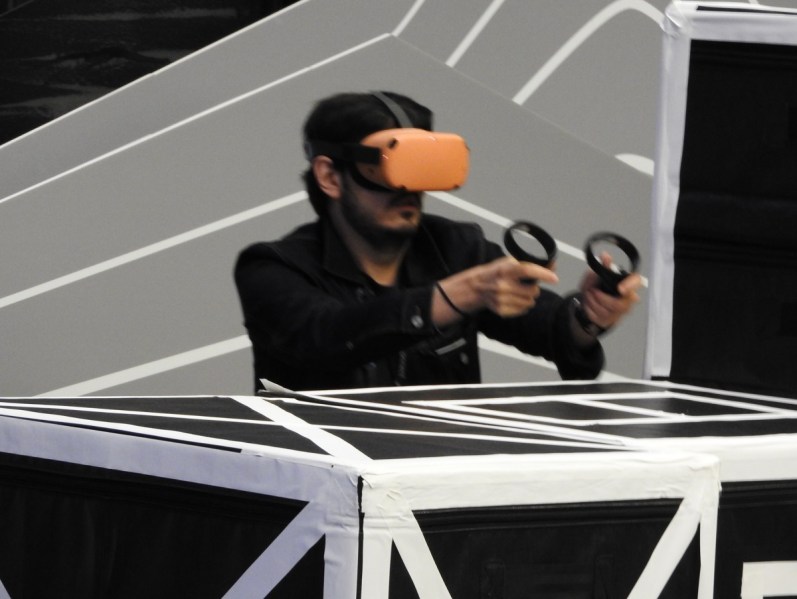
Above: Dead & Buried with the Oculus Quest in a very big arena.
Allison: The Oculus Quest is looking pretty good at $400.
Fallah: It’s looking good, but by the time it comes out it’s already yesterday’s technology. The SDC, our developer conference, is in three weeks. We have two games showing there that have such a high polygon count that you can only play them on Odyssey. One is from a big triple-A studio that you all know. We want more of that, that high-end quality. 835 chips are not going to do it.
I’ll be honest. We’re running 855s right now and it can barely run the kind of things that we like. We have amazing screens. We have patterns that take the SD effect out of it. We can run 4K by 4K screens inside the headset and keep that under $500 right now. There’s no point in bringing it up. The rest of the infrastructure isn’t there. The front side of it is one thing, too. You need the back side as well. We’re all waiting for 5G to take off. In fact, we’re bringing 5G generators to the Moscone Center, just so everyone can experience what actual 5G is like. It’s going to be a game-changer for VR and AR.
There are certain things in the background that need to happen, infrastructure things, that will probably happen in some countries before others. But it will go over that side in the next two or three years. If you look at it globally, a lot of the countries that were stuck on 2G or 3G systems are now upgrading to 4G. The 4G guys are upgrading to 5G over the next two or three years. That’s very exciting.
I was recently asked about what I’m most excited about that’s happened in the last six months, and I said, “Not a hell of a lot.” But I’m really excited about what’s happening in the next 12-18 months. Ourselves and some of our competitors, we have some exciting products waiting in the wings. We’ll show our AR products in three weeks at SDC. This stuff is not as far away as you think. We actually have hardware made for the next two or three years already. It’s amazing stuff. You’re going to be excited in the next 18 months, seeing some of the things that are coming out.
Question: A good friend of mine used to say that good interactivity is more important than good graphics. We see things like Angry Birds become huge hits, not exactly high-end graphics there. Do you think one is more important, or do they both go hand in hand?
Allison: Beat Saber isn’t really a technological wonder, but it’s really popular. Another thing that makes it confusing for me is that it doesn’t really need to be in VR. Why is that game in VR? But I’m in there all the time playing it, so there must be something pretty awesome about it.
But yes, that’s another example. You need something fun and engaging. The way it’s designed, how you grow your achievements throughout, is really addictive. Certain games are better at it than others. You don’t need to have incredible graphics unless that really enriches your story, or you have three years of development to really polish it.
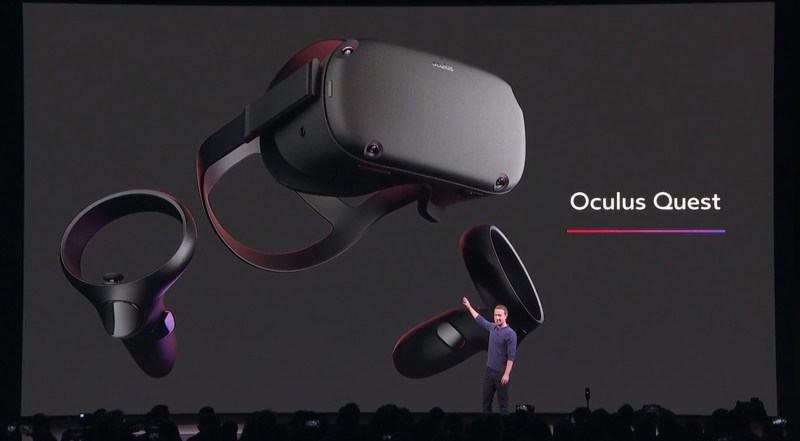
Above: The Oculus Quest sits behind the Touch controllers.
GamesBeat: The Oculus Quest is interesting in that it’s not high-end. It can’t do what the Oculus Rift can do. But it may be good enough anyway, because it’s the only thing that lets you swing a lightsaber around with two hands, 360 degrees. It’s no surprise that they have a Star Wars game to show it off. I feel like the opportunity there is to be something like the Nintendo Wii of VR. If they can capture that market, Nintendo has shown that there’s a large group of people out there who don’t demand the highest-end graphics.
Question: In the traditional mobile gaming space, free-to-play is a very popular business model. You charge for cosmetics and extra content. Is that a viable business model for VR game content?
Fallah: We think so. Once we reach a critical mass of players, that will be a viable business model, depending on what your game does. We were talking earlier about sampler games. Free-to-play games are always easier because we have such a small market right now, and a demographic that isn’t as willing to spend a lot of money. They come in and take a look and hopefully see some things they like inside.
We have a few games that are coming out like that and doing well by VR standards. Maybe not by mobile standards. We talk about eight-digit numbers when we talk about mobile. But it is viable in the long term.
Allison: Personalization will get bigger as the platform moves forward. That’s a big area of microtransactions. It also depends on how in-game or in-experience purchases are done through your interface. People find it really obnoxious to be immersed in a world and then all of a sudden they’re asked to purchase something. That might not work well in VR. It depends on how well it’s woven into the experience.
Question: Where is most of the developer investment going toward now? Is it the lighter, mobile headsets, the 835s, or is it desktop?
Fallah: Right now we’ve heard about some VR companies getting investment recently. Revolution Games got some nice investment. You have the Magic Leap products coming out, and some others. But really, most of the money right now is going to AR. Part of the reason for that is that AR doesn’t have the limitations in VR that we were talking about earlier. The platforms are much more open. AR is more robust. People are more familiar with it. It’s more usable for the regular user, outside the VR demographic we were talking about.
Having said that, all of our new products coming out in 2019 and onward will incorporate AR and VR together. They will not be separate products. We’ll have AR wearables out. Several will be coming out over the next two years. They’re intended more for the regular user that just wants utility applications, rather than a full entertainment suite. But we don’t think VR is going away.
Part of the reason we want the higher-end graphics we were discussing is because the lower-end graphics are appealing mostly to the demographic like me, Gen X and before. We don’t mind if a game doesn’t have the greatest graphics. But we find that the newer generation, the ones that we really want to bring into this, they can’t afford as much, but they want to have the higher-end graphics.
The new way of living is different. People cohabitate with more people in their houses now. We realize that privacy is hard to find in today’s world. VR, by its nature, is kind of your own little private world. You can live with five roommates, but then you put on your headset and you’re alone in that world. Believe it or not, the top three VR applications, to this day — and we have more than 10 million users on Samsung VR, so we have pretty good numbers — are still services like Netflix and other movies. We can cross-reference with other things and find out that a lot of these people have our beautiful high-end TVs in their homes. Why are they watching on the VR headset? Because that’s easier for them.
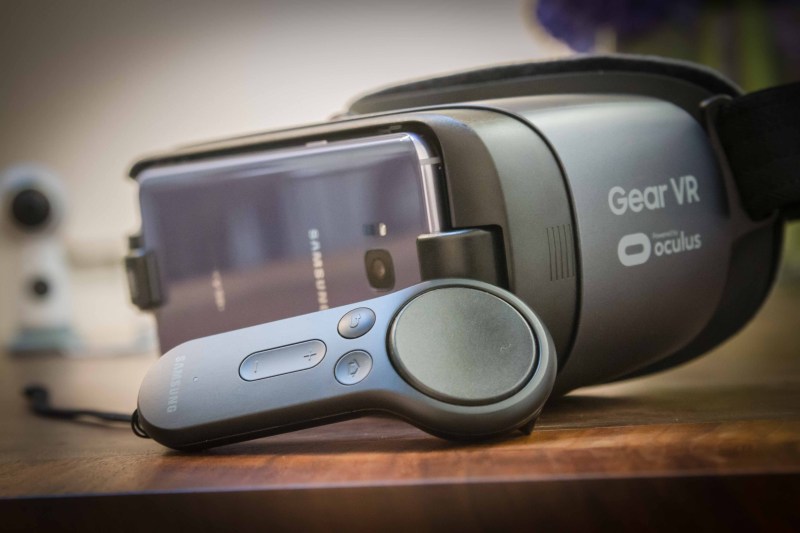
Above: Samsung’s Gear VR headset and Oculus-powered controller.
Allison: My friend has it next to his bed, with his wife. If she’s sleeping he can still watch something without disturbing her.
Fallah: Every week it still amazes me. “They’re watching so much Netflix in their headsets. Why?”
Allison: Because you can isolate yourself. Like you said, it’s about privacy a lot of times.
Fallah: And that’s the wave of the future, more and more. Anybody who lives around here is probably familiar with that. I grew up in San Francisco, and I’ve watched privacy gradually go away in San Francisco. That’s why we need the better graphics, the better solutions.
People ask if mobile is the way of the future. Not mobile in the sense of, it’s attached to a phone. But mobility, yes. VR has to be able to go with you. Whatever the headset is, for it to go mainstream you have to be able to carry it everywhere with you, with or without a phone. Four or five years from now, that will be a reality.
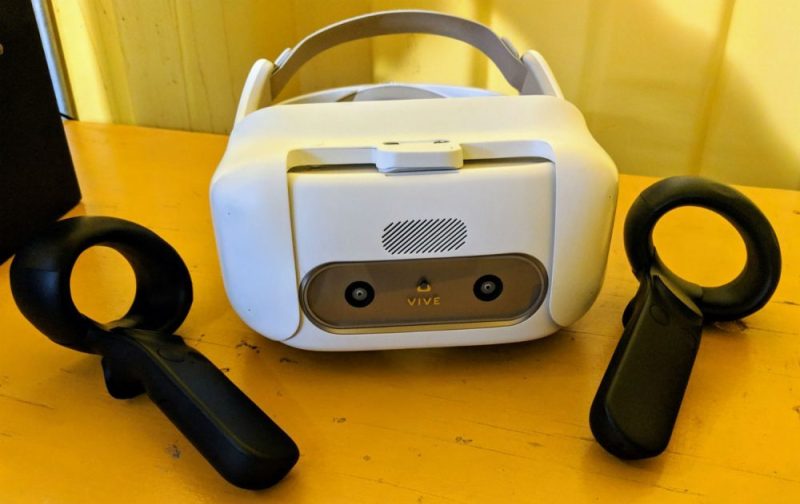
Above: The new Vive Focus 6 degress of freedom dev kit and controllers.
Question: I opened a VR arcade in 2016, about six months after Vive came out, and we’re participating in the first Archangel arcade tournament. Our guys won in the second elimination round, so I’m really excited about that. I have to say, one of the most exciting esports experiences I’ve ever seen was watching our two guys show up there. I hope that becomes a bigger part of the esports community.
As a VR arcade owner, what we really want to do is build the influencer community in our area. I was wondering if you have any tools or recommendations on how to build a VR enthusiast community in our area and get connected with local VR players.
Allison: It’s really cool that you bring that up, because we’ve been giving that a lot of thought as well. We’ve been thinking about, for example–with a tournament, if there are 16 arcades doing really localized buys on Facebook or any other social media, they can find people in their local areas to push them there. We’ve also talked about, with the next thing we’re doing, which is the Walking Dead, doing something that’s almost like a tour. Influencers are all over the world, but if you can find them and bring them together in one place, you can do events at places like an arcade.
There are lots of things to do. It’s just always about the budget. Nobody in VR is making money yet, so saying things like, “I’m going to throw a bus tour!” sounds really great until you start running the numbers and putting them in front of your boss. But that’s why we’re trying to find reasonable ways to get people interested. Things like point of purchase standees for your place where people can come and do a pose, something that brings people through your doors. Or events where we push people there even if we can’t go ourselves. We’re exploring it and we’re very interested. It’s just a question of where those dollars can come from. We’re open to ideas.
